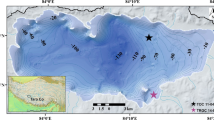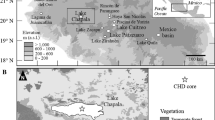Abstract
Recent sediments of eight small lakes in the northern winter range of Yellowstone National Park were cored to examine stratigraphic records of past changes in limnology and local environment that might be attributed to grazing and other activities of elk, bison, and other large ungulates. Cores of undisturbed sediment were analyzed at close intervals to depths covering the last 100–150 years according to chronologies established by lead-210 dating. Pollen analyses were made to show change in regional vegetation, and diatom and geochemical analyses were made to reveal possible limnological changes resulting from soil erosion and nutrient input from the lake catchments.
Variations in sedimentary components prior to establishment of the Park in 1872 indicate some natural variability in environmental factors e.g., erosional inputs in landslide areas west of Gardiner. All lakes had abundant nutrient inputs.
After the Park was founded, fire suppression may have been responsible for small increases in pollen percentages of various conifers and Artemisia tridentata (big sagebrush) at different times in different lakes. Perceptible decreases in pollen of willow, aspen, alder, and birch at different times may reflect local ungulate browsing, although drier climatic conditions may have been a factor as well.
The most striking manifestation of accelerated erosion in a catchment was found at a lake located beside a road constructed in the 1930s. In contrast to changes at this site, the record of erosion at other lakes is hardly perceptible. Changes in sediment-accumulation rates seen at most sites result from redistribution of sediment within the lake after initial deposition.
In the century following Park establishment, the abundance of planktonic diatoms relative to benthic taxa varies among lakes and may reflect differential nutrient inputs or changes in lake level. Four of the five lakes analyzed for diatoms show in the last few decades an increase in planktonic relative to benthic species, implying elevated nutrient inputs. The recent flora, however, is similar to that in pre-Park levels which suggests that these lakes have not been perturbed outside their normal range. Increased nutrient supply in recent decades for at least two of the lakes is supported by the geochemical data, which show an increase in biogenic silica and in organic matter.
As a whole, our investigation of the sedimentary record does not support the hypothesis that ungulate grazing has had a strong direct or indirect effect on the vegetation and soil stability in the lake catchments or on the water quality of the lakes.
Similar content being viewed by others
References
Appleby, P. G. & F. Oldfield, 1978. The calculation of lead-210 dates assuming a constant rate of supply of unsupported 210Pb to the sediment. Catena 5: 1–8.
Appleby, P. G. & F. Oldfield, 1983. The assessment of 210Pb data from sites with varying sediment accumulation rates. Hydrobiologia 103: 29–35.
Battarbee, R. W., 1978. Biostratigraphical evidence for variations in the recent pattern of sediment accumulation in Lough Neagh, N. Ireland. Verh. int. Ver. Limnol. 20: 624–629.
Binford, M. W., 1990. Calculation and uncertainty analysis of 210Pb dates for PIRLA project lake sediment cores. J. Paleolim. 3: 253–267.
Brugam, R. B., 1980. Postglacial diatom stratigraphy of Kirchner Marsh, Minnesota. Quat. Res. 13: 133–146.
Chase, A., 1986. Playing God in Yellowstone. Atlantic Monthly Press, New York, New York, 446 pp.
Dean, J. L., J. D. Varley & R. E. Gresswell, 1974. Fishery and aquatic management program in Yellowstone National Park. U.S. Fish and Wildlife Service Technical Report, Yellowstone National Park, Wyoming.
Dean, W. E.Jr., 1974. Determination of carbonate and organic matter in calcareous sediments and sedimentary rocks by loss on ignition: comparison with other methods. J. Sed. Petrol. 44: 242–248.
Dean, W. E., 1981. Carbonate minerals and organic matter in sediments of modern north temperate hard-water lakes. SEPM Spec. Pub. 31: 213–231.
Dearing, J. A., 1983. Changing patterns of sediment accumulation in a small lake in Scania, southern Sweden. Hydrobiologia 103: 59–64.
Despain, D., D. Houston, M. Meagher & P. Schullery, 1986. Wildlife in transition. Roberts Rinehart, Boulder, Colorado, 142 pp.
Despain, D. G., 1975. Field key to the flora of Yellowstone National Park. Yellowstone Library and Museum Association, Yellowstone National Park, Wyoming, 257 pp.
Dirks, R. A. & B. E. Martner, 1982. The climate of Yellowstone and Grand Teton National Parks. National Park Service Occasional Paper No. 6, Yellowstone National Park, Wyoming.
Eakins, J. D. & R. T. Morrison, 1978. A new procedure for the determination of lead-210 in lake and marine sediments. Int. J. Appl. Radiat. Isot. 29: 531–536.
Engstrom, D. R. & E. B. Swain, 1986. The chemistry of lake sediments in time and space. Hydrobiologia 143: 37–44.
Engstrom, D. R. & H. E. WrightJr., 1984. Chemical stratigraphy of lake sediments as a record of environmental change. In E. Y. Haworth & J. W. G. Lund (eds.), Lake Sediments and Environmental History. Univ. Minnesota Press, Minneapolis: 11–67.
Faegri, K. & J. Iversen, 1975. Textbook of pollen analysis. Munksgaard, Copenhagen.
Gennett, J. A. & R. G. Baker, 1986. A late Quaternary pollen sequence from Blacktail Pond, Yellowstone National Park, Wyoming, U.S.A. Palynology 10: 61–71.
Haines, A. L., 1977. The Yellowstone story, vols. 1 and 2. Yellowstone Library and Museum Association, Yellowstone National Park, Wyoming.
Houston, D. B., 1973. Wildfires in northern Yellowstone National Park. Ecology 54: 1111–1117.
Houston, D. B., 1982. The northern Yellowstone elk. Macmillan and Company, New York, New York, 500 pp.
Jonas, R. J., 1955. A population and ecological study of the beaver—Castor canadensis—of Yellowstone National Park. M.S. thesis, University of Idaho.
Jones, R. D., J. D. Varley, R. E., Gresswell, D. E., Jennings & S. M. Rubrecht, 1978. Fishery and aquatic management program in Yellowstone National Park. U.S. Fish and Wildlife Service Technical Report, Yellowstone National Park, Wyoming.
Kay, C., 1984. Aspen reproduction in the Yellowstone Park-Jackson Hole areas and its relation to natural regulation of ungulates. Proceedings of a symposium on elk and their habitat, Logan, Utah.
Krishnaswamy, S. & D. Lal, 1978. Radionuclide limnochronology. In A. Lerman (ed.), Lakes, Chemistry Geology Physics. Springer-Verlag, New York: 153–177.
Lovstad, O., 1984. Growth limiting factors for Oscillatoria agardhii and diatoms in eutrophic lakes. Oikos 42: 185–192.
Murchie, S. L., 1985. 210Pb dating and the recent geologic history of Crystal Bay, Lake Minnetonka. Limnol. Oceanogr. 30: 1154–1170.
Oldfield, F. & P. G. Appleby, 1984. Empirical testing of 210Pb-dating models for lake sediments. In E. Y. Haworth & J. W. G. Lund (eds.), Lake Sediments and Environmental History. Univ. Minnesota Press, Minneapolis: 93–124.
Sharpe, P. A. & B. B. Arnold, 1966. Fishery and aquatic management program in Yellowstone National Park. U.S. Fish and Wildlife Service Technical Report, Yellowstone National Park, Wyoming.
Smol, J. P., 1985. The ratio of diatom frustules to chrysophycean statospores: a useful paleolimnological index. Hydrobiologia 123: 199–208.
Smol, J. P. & M. D. Dickman, 1981. The recent histories of three Canadian Shield lakes: A paleolimnological experiment. Arch. Hydrobiol. 93: 83–108.
Tilman, D., S. S. Kilham & P. Kilham, 1982. Phytoplankton community ecology: the role of limiting nutrients. Ann. Rev. Ecol. Syst. 13: 349–372.
Waddington, J. C. B. & H. E. WrightJr., 1974. Late Quaternary vegetational change on the east side of Yellowstone Park, Wyoming. Quat. Res. 4: 175–184.
Warren, E. R., 1926. The beaver in Yellowstone and Estes Parks. Roosevelt Wild Life Ann. 1: 12–234.
Author information
Authors and Affiliations
Rights and permissions
About this article
Cite this article
Engstrom, D.R., Whitlock, C., Fritz, S.C. et al. Recent environmental changes inferred from the sediments of small lakes in Yellowstone's northern range. J Paleolimnol 5, 139–174 (1991). https://doi.org/10.1007/BF00176875
Received:
Accepted:
Issue Date:
DOI: https://doi.org/10.1007/BF00176875




